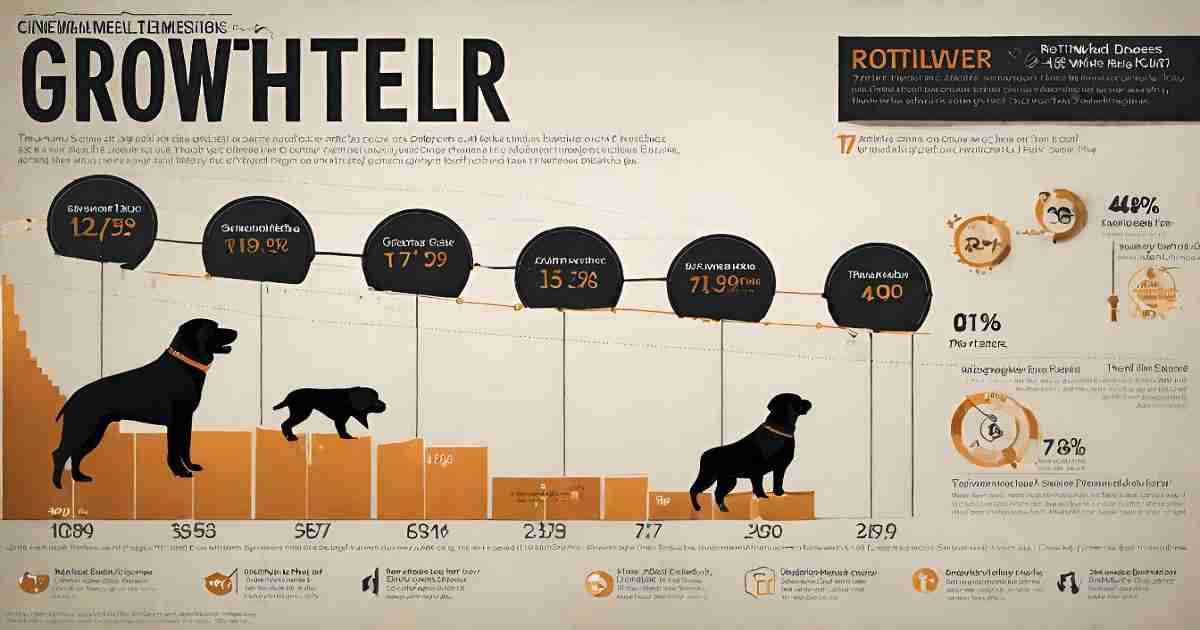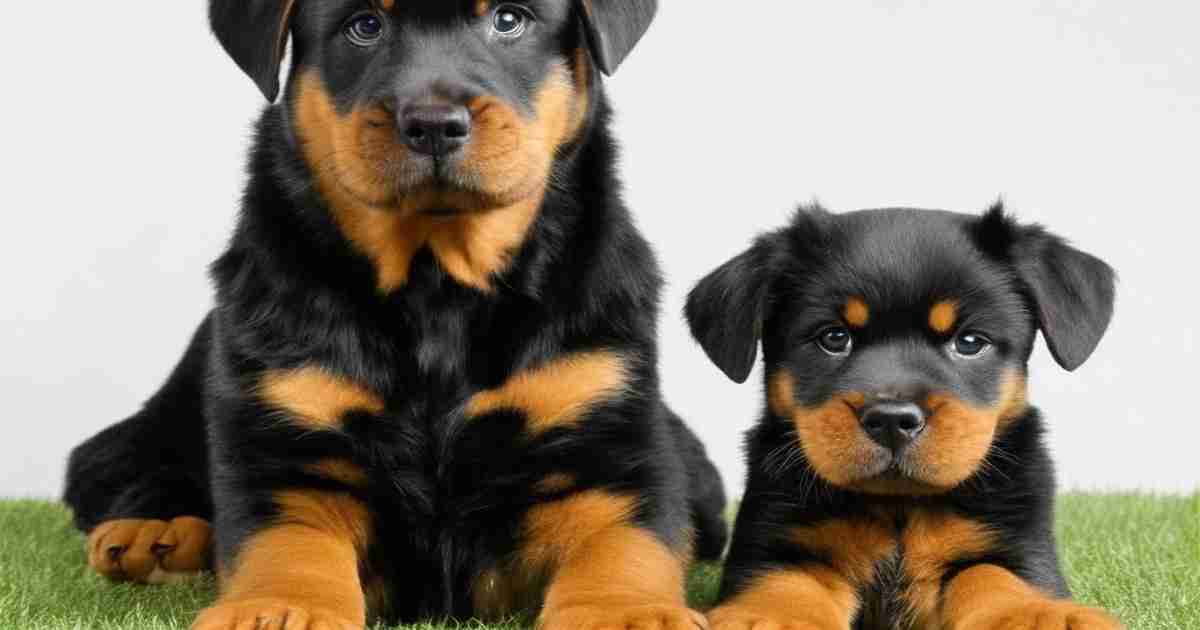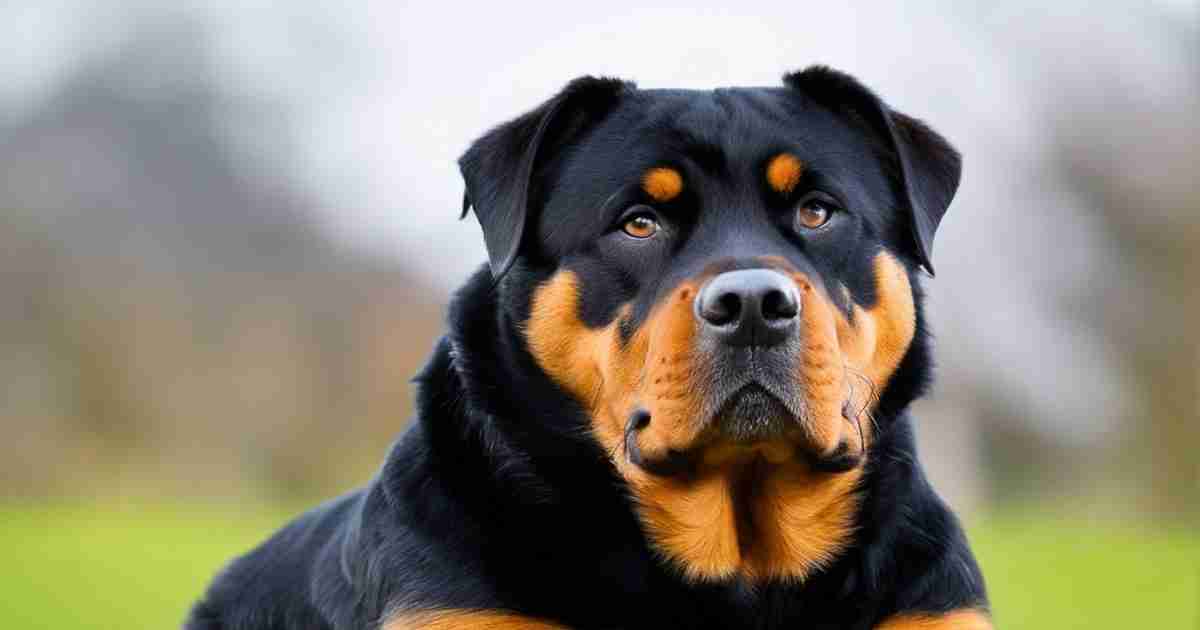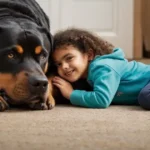So you just brought home an adorable Rottweiler puppy. Those big paws and loose skin hint that your little furball is going to grow—a lot!
As a large breed dog originally bred for herding livestock, Rottweilers grow rapidly during their first year and continue maturing into strong, sturdy adults. But When Is a Rottweiler Fully Grown?
Many new Rottweiler owners are eager to know when their pup will reach full adult size. The answer depends on whether you mean their height, weight or overall physical maturity.
While Rottweilers approach their maximum height around 18 months old, they continue filling out with muscle and broadening their chests until age 2 or 3.
Their mental maturity lags even further behind. Understanding the growth timeline and factors that influence your Rottweiler’s size will help you provide proper care during this transformative time.
When Do Rottweilers Stop Growing Upward?
The height of a Rottweiler is primarily determined by genetics, with some variation based on nutrition and overall health. Here are the key points on when Rottweilers reach their maximum height:
- Male Rottweilers generally stop gaining height at 18-24 months old. Their growth plates, which are areas of cartilage near the joints that turn into solid bone as the dog matures, close during this period and the long bones stop extending.
- Female Rottweilers typically reach their full height a bit earlier, around 16-20 months old.
- While the average timeframes are clear, there can be considerable variation between individual dogs. Some Rottweilers continue having minor growth spurts past 24 months.
Factors That Influence Adult Height
Several variables play a role in determining the final size of a Rottweiler:
- Genetics – Rottweilers from larger parents tend to be taller themselves. There is an inherited component that sets parameters for growth potential.
- Nutrition – Well-fed puppies with balanced diets containing sufficient protein usually grow faster and larger than undernourished litter mates.
- Physical Activity – Regular exercise stimulates the release of growth hormones. Puppies allowed outdoor activity typically develop longer limbs.
- Health – Illnesses, parasites, orthopedic issues or other physical defects can stunt growth. Healthy pups grow better.
- Spay/Neuter Status – Intact dogs extend their growth period longer and often end up taller than dogs fixed at a young age. The removal of hormones slows bone growth.
So monitor your Rottweiler puppy’s height as he approaches 18-24 months. Once his growth plates fuse and upward development stops, you can determine his final adult stature. But don’t be alarmed if he sprouts a bit more after that!
When Do Rottweilers Stop Growing Outward?
While Rottweilers reach their full height as young adults, they continue increasing in overall size and weight for several more months. Here’s an overview of their outward growth timeline:
- Male Rottweilers take 2-3 years to reach their maximum muscle mass and broad chest size. Their heads become more massive as well.
- Female Rottweilers typically achieve their fully developed proportions by 1.5-2.5 years old.
- Spayed/neutered dogs often take 6-12 months longer than intact dogs to finish growing. The lack of sex hormones likely extends their growth period.
Factors That Influence Weight Gain
Several variables affect the rate at which Rottweiler puppies fill out:
- Diet – Puppies need 30-40 calories per pound per day. Insufficient nutrition prevents adequate growth. Excess calories lead to obesity.
- Exercise – Regular physical activity, especially swimming and walking, builds lean muscle mass. Inactive dogs are more prone to fat.
- Age – Rottweilers experience a final maturation around 5-6 years old when growth hormones wane. Skeletal changes slow down and weight gain levels off.
- Health Issues – Diseases affecting appetite, absorption, metabolism or mobility can cause abnormal weight loss or gain. Medications also impact weight.
Monitor your Rottweiler’s body condition score as he matures. Adjust food portions and exercise as needed to keep him fit and muscular. With ideal care, he’ll achieve his genetically predisposed size by adulthood.
Typical Adult Rottweiler Size
Once a Rottweiler is fully grown, what size can you expect? Here are the typical dimensions for mature male and female Rottweilers:
Male Rottweilers
- Height – 24 to 27 inches tall at the shoulder
- Weight – 115 to 135 pounds
Female Rottweilers
- Height – 22 to 25 inches tall at the shoulder
- Weight – 80 to 100 pounds
However, there is significant variation among individual dogs based on lineage, diet, exercise and health.
Factors influencing adult size:
- Genetics – Rottweilers from larger lines tend to exceed standard sizes.
- Nutrition – Overfeeding leads to overweight dogs. Underfeeding leads to underweight dogs.
- Spay/neuter – Intact dogs tend to be taller and more massive.
- Exercise – Active dogs develop more muscle mass.
- Health – Medical issues can restrict growth.
- Mixes – Crossbred Rottweilers are less predictable in size.
While most Rottweilers fall within the typical size range, it’s not unusual for some males to reach 130-150 pounds or some females to be 60-90 pounds. There are even rare giant Rottweilers outside the normal parameters.
As long as your dog is proportional and healthy, moderate variations in size should not be a concern. Focus on proper feeding, exercise and veterinary care rather than obsessing over the scale. Your Rottweiler’s ideal weight is one where he is fit and energetic.
Signs Your Rottweiler Fully Grown
How can you tell when your Rottweiler has finished maturing and reached his adult size? Here are some signs that your pup is fully grown:
- Slowing of weight gain – The rapid weight increases of puppyhood taper off around 1-2 years old as growth hormones decrease. Your Rottweiler is likely full grown if weight gain levels off despite consistent eating and exercise.
- Reaching consistent height – Once male Rottweilers hit 24-27 inches and females reach 22-25 inches, you can consider their height fixed. Monitor weekly to confirm growth plates have closed.
- Filling out of chest and neck – Adult male Rottweilers develop a broad chest and thick neck. Their heads become more massive as well. This maturation happens between 2-3 years old.
- Onset of mature temperament – As Rottweilers leave adolescence, they exhibit more stable, relaxed dispositions. Less erratic behavior signifies physical and mental maturity around 2-3 years old.
- Closing of growth plates on x-rays – Veterinarians can take x-rays of the long bones around age 2 to visually confirm that the growth plates have fused, meaning upward growth has ceased.
- Reaching breed standards – When your Rottweiler matches the American Kennel Club’s specifications for height, weight and proportions for his sex, he can be considered fully grown.
Keep in mind that some Rottweilers may take up to 36 months to finish filling out. However, most males will hit their adult target measurements by using 24–30 months and females by using 18–24 months. Consult your veterinarian when you have issues with your Rottweiler’s development.
Caring for Your Maturing Rottweiler
The transition period from puppyhood to adulthood is an important time for Rottweilers. Here are a few tips for caring in your Rottweiler as he bodily matures:
Transition to adult food – Around 12-18 months old, progressively switch your Rottweiler from puppy meals to person food formulated for huge breeds. The decrease calories and protein degrees will support lean muscle development.
Continue obedience training – Just because your Rottweiler is bodily mature does not imply his training is complete. Give a boost to commands and socialization for the duration of maturity to make sure top-notch behavior.
- Monitor weight – Weigh your Rottweiler weekly or monthly to seize any dangerous fluctuations. Modify meals and exercise hence to keep him fit.
- Provide exercise – Adult Rottweilers want at least 2 hours of interest per day. Take long daily walks and play fetch to satisfy their exercise desires.
- Check health frequently – Visit your vet for twice annual wellness exams to monitor for issues like hip dysplasia that may appear in adulthood.
- Socialize consistently – Make sure your Rottweiler has positive experiences with people and other dogs. Socialization prevents aggressive tendencies.
- Adjust diet as needed – Your Rottweiler may need diet changes as he ages to account for decreased activity levels and metabolism slow down.
- Remain patient – Your Rottweiler can also still show off puppy-like behaviors as his mental adulthood lags behind his body. Reply with calm, company steering.
- With attentive care and routine vet visits, your Rottweiler will thrive as he transitions into a full grown adult dog. Stay alert for any emerging medical or behavioral issues requiring intervention.
Conclusion
To summarize the key points:
- Rottweilers are considered fully grown when their physical development peaks, usually between 2-3 years old. Their maximum height is reached earlier, around 16-24 months old, but their body fills out until 24-36 months old.
- Several factors influence the exact timing and size of growth, including genetics, diet, exercise, health and spay/neuter status. There is variation among individual dogs.
- Male Rottweilers end up 24-27 inches tall and 115-135 pounds on average. Females are generally 22-25 inches tall and 80-100 pounds.
- Monitor your Rottweiler’s rate of height gain and weight gain over time. When their growth plates fuse, height stabilizes. Slower weight gain indicates maturity.
- Proper nutrition, training, socialization and veterinary care are essential while your Rottweiler transitions from puppy to adult.
- With appropriate care and attention, your Rottweiler will mature into a beautiful, well-mannered companion animal.
Understanding the developmental stages of Rottweilers allows owners to set appropriate expectations and provide supportive care. If you have any other questions about your Rottweiler’s growth, consult your veterinarian.








